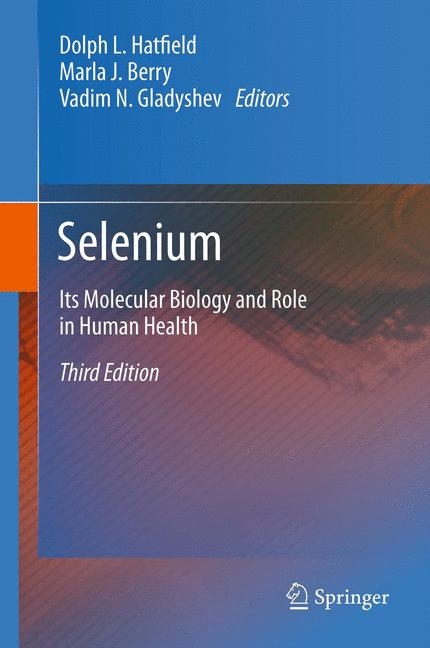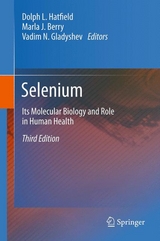Selenium
Springer-Verlag New York Inc.
978-1-4614-1024-9 (ISBN)
- Titel erscheint in neuer Auflage
- Artikel merken
Many health benefits have been attributed to selenium that include preventing various forms of cancer (e.g., colon cancer, prostate cancer, lung cancer and liver cancer), heart disease and other cardiovascular and muscle disorders, inhibiting viral expression, delaying the progression of acquired immunodeficiency syndrome (AIDS) in human immunodeficiency virus (HIV)-positive patients, slowing the aging process, and having roles in mammalian development, including male reproduction and immune function. The purpose of the book is the same as the first two volumes which is to bring an up to date status of current research in the rapidly developing selenium field centered around the health benefits attributed to this element and how this element makes its way into protein.
Foreword.- Preface.-Dedication.- Acknowledgements.- Chapter 1- History of selenium research.- Part I. Selenocysteine biosynthesis and incorporation into protein.- Chapter 2- Selenocysteine biosynthesis and the replacement of selenocysteine with cysteine in the pathway.- Chapter 3- Molecular mechanism of eukaryotic selenocysteine incorporation.- Chapter 4- SECIS binding proteins regulate the expression of the selenoproteome .- Chapter 5- A ribosomal perspective on the mechanism of selenocysteine incorporation.- Chapter 6- Chemical basis for the use of selenocysteine.- Chapter 7- Evolutionary basis for the use of selenocysteine.- Chapter 8- Selenocysteine lyase: Mechanism, structure and biological role .- Part II. Selenoproteins and selenoproteins in health.- Chapter 9- Selenoproteins and selenoproteomes .- Chapter 10- Structural characterization of mammalian selenoproteins.- Chapter 11- Selenoproteins: Hierarchy, requirements and biomarkers .- Chapter 12- Selenoproteins and the thioredoxin system.- Chapter 13- Selenoproteins of the glutathione peroxidase family.- Chapter 14- Glutathione peroxidase 4.- Chapter 15- Selenoprotein M.- Chapter 16- Selenium transport in mammals: Selenoprotein P and its receptors.-Chapter 17- Selenoproteins in the endoplasmic reticulum.- Chapter 18- Selenoproteins in nervous system development, function and degeneration.- Chapter 19- Selenoproteins in cardiovascular redox pathology.- Chapter 20- Glutathione peroxidase 1 and diabetes.- Chapter 21- Glutathione peroxidase 2 and its role in cancer.- Chapter 22- Selenoprotein N: Its role in disease.- Part III. Selenium and selenoproteins in human health.- Chapter 23- Prostate cancer prevention and the Selenium and Vitamin E Cancer Prevention Trial (SELECT): A selenium perspective.- Chapter 24- Selenium as a cancer preventive agent.- Chapter 25- Selenoproteins harboring a split personality in both preventing and promoting cancer.- Chapter 26- An emerging picture of the biological roles of selenoprotein K .- Chapter 27- Polymorphisms in selenoprotein genes and cancer.- Chapter 28- Schizophrenia, oxidative stress and selenium .- Chapter 29- Control of thyroid hormone activation and inactivation by the iodothyronine deiodinase family of selenoenzymes .- Chapter 30- Role of selenium in HIV/AIDS.- Chapter 31-Seafood selenium in relation to assessments of methylmercury exposure risks.- Chapter 32- Selenium and male reproduction.- Chapter 33- Variations in selenium metabolism in males and females.- Chapter 34- Selenium in Alzheimer's disease.- Chapter 35- Selenium and inflammation.- Chapter 36- Selenium metabolism in prokaryotes.- Chapter 37-Selenoproteins in parasites.- Chapter 38- Selenium and methionine sulfoxide reduction.- Chapter 39- Inactivation of glutathione peroxidase 1 and peroxiredoxin 2 by peroxides in red blood cells.- Chapter 40- Functional aspects of the genomics of selenoprotein and selenocysteine incorporation machinery genes.- Chapter 41- Selenium: Dietary sources and human requirements.- Chapter 42- Selenium and adverse health conditions of human pregnancy.- Part IV. Mouse models for elucidating the role of selenium and selenoproteins in health.- Chapter 43- Mouse models for glutathione peroxidase 4 (GPx4).- Chapter 44- Mouse models that target removal or over-expression of the selenocysteine tRNA[Ser]Sec gene to elucidate the role of selenoproteins in health and development.- Chapter 45-Selenoproteins in skeletal development and disease: Lessons from Trsp deletion in murine bone and cartilage progenitor cells
| Zusatzinfo | 17 black & white tables, biography |
|---|---|
| Verlagsort | New York, NY |
| Sprache | englisch |
| Maße | 155 x 235 mm |
| Gewicht | 1087 g |
| Themenwelt | Studium ► 1. Studienabschnitt (Vorklinik) ► Physiologie |
| Studium ► Querschnittsbereiche ► Infektiologie / Immunologie | |
| Naturwissenschaften ► Biologie ► Biochemie | |
| ISBN-10 | 1-4614-1024-X / 146141024X |
| ISBN-13 | 978-1-4614-1024-9 / 9781461410249 |
| Zustand | Neuware |
| Haben Sie eine Frage zum Produkt? |
aus dem Bereich





